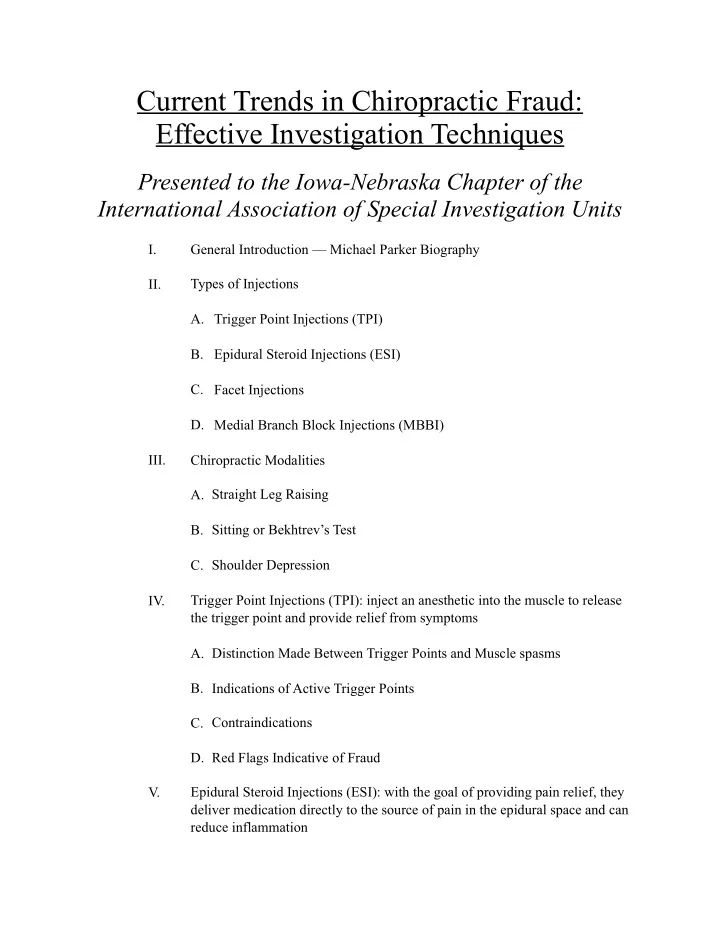

Current Trends in Chiropractic Fraud: Effective Investigation Techniques Presented to the Iowa-Nebraska Chapter of the International Association of Special Investigation Units I. General Introduction –– Michael Parker Biography II. Types of Injections A. Trigger Point Injections (TPI) B. Epidural Steroid Injections (ESI) C. Facet Injections D. Medial Branch Block Injections (MBBI) III. Chiropractic Modalities A. Straight Leg Raising B. Sitting or Bekhtrev’s Test C. Shoulder Depression IV. Trigger Point Injections (TPI): inject an anesthetic into the muscle to release the trigger point and provide relief from symptoms A. Distinction Made Between Trigger Points and Muscle spasms B. Indications of Active Trigger Points C. Contraindications D. Red Flags Indicative of Fraud V. Epidural Steroid Injections (ESI): with the goal of providing pain relief, they deliver medication directly to the source of pain in the epidural space and can reduce inflammation
A. Definition of Epidural Space B. Risks associated with ESIs C. Red Flags Indicative of Fraud VI. Facet Injections: inject a small amount of local anesthetic and/or steroid medication into the joint to numb the facet joints and block pain A. Definition of Facet Joints B. Facet Injections Diagnose and Mitigate the Pain VII. Medial Branch Block Injections (MBBI): inject an anesthetic outside the facet joint space near the medial branch that contributes and connects to a specific facet joint A. Definition of the Medial Branch B. MBBIs Diagnose the Pain and Determine Eligibility for Pain-Relieving Procedures C. Red Flags Indicative of Fraud VIII. Legitimate Reasons for Injections A. Appropriate Symptomatology B. Appropriate Diagnostic and Radiological Research C. Unsuccessful Conservative Treatment IX. Spotting Unnecessary Injections A. Lack of Conservative Treatment/Records B. Lack of Orthopedic Tests and Neurological Findings C. Excessive Injections Administered D. Injections Inconsistent with Symptomatology
E. Fluoroscopy Guidance Not Used F. Lack of Proper Follow-up Procedures X. Treatment Abuse: Front End A. Initial Evaluation Did Not Locate Trigger Points B. Yet the “Treatment Plan” Includes “Myofascial Trigger Point Therapy” XI. Treatment Abuse: Back End A. Patient Received Lumbar Epidural Steroid and Trigger Point Injections B. These Injections Are Not Medically Necessary XII. Billing Abuse XIII. Questions XIV. General Introduction –– Jason D. Tomlin Biography XV. Current Trends in Fraud A. Government Analogy B. Cookie-Cutter Billing C. Chiropractic Care As Big Business D. Red Flags Indicating Fraud XVI. MCIU Investigation A. Sample Questions that Elicit Patterns across Files B. Theme of Question Outline C. MCIU Should Be Aware of Some Patterns that Parker Straus Discovered D. Overcharging As Motive E. Overcharging with Protocol Treatment As Fraud
XVII. Major Fraud Pre-litigation Areas of Focus XVIII. Pre-litigation Settlement Conference and Litigation A. MCIU Role B. Necessary Witnesses to Prove Case XIX. What Are the Issues? A. Inflated Medical Billing B. Missing Medical Records C. Assessing Claims and Claims Pressures XX. Pre-suit Discovery Tools XXI. Pre-suit Discovery by State XXII. Texas Rule 202 A. When Can You Use Rule 202? B. Rule 202 Allows Authority for Document Production C. Rule 202 Procedure and Hearing D. Rule 202 Goals and Strategy XXIII. Claim of John Doe: Study on Value of Rule 202 A. Red Flags in Claim of John Doe B. Rule 202 Petition C. Deposition Summaries XXIV. Inconsistencies across Claimants A. Received Cortisone Shots B. No Records of Some Allegedly Received Shots
C. No Monitoring Devices Used D. No Sedatives Administered E. Denied Receiving CMTs F. Description of Injuries Contradicts Records XXV. After the Rule 202 Depositions XXVI. General Introduction –– Emily G. Cottingham Biography XXVII.Affirmative Litigation A. Jurisdiction B. Venue C. Considerations D. Application in Court E. Voir Dire XXVIII.Discussion Debunking Traditional Notions of Jurisdiction and Venue XXIX. The Good News: We’re the Good Guys. Really. Voir Dire Demonstrations XXX. Finishing Strong A. Closing B. Jury Instructions XXXI. Goals A. Deterrent B. Recoup Damage Money C. Affect Billing Practices Industry-wide
Recommend
More recommend